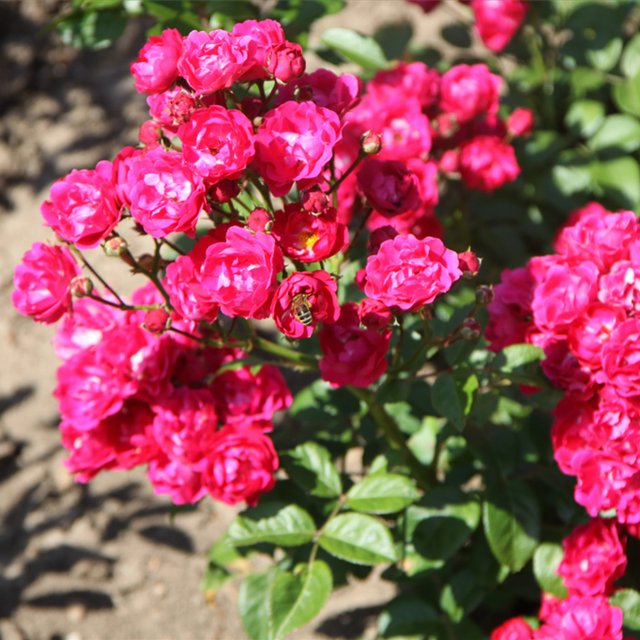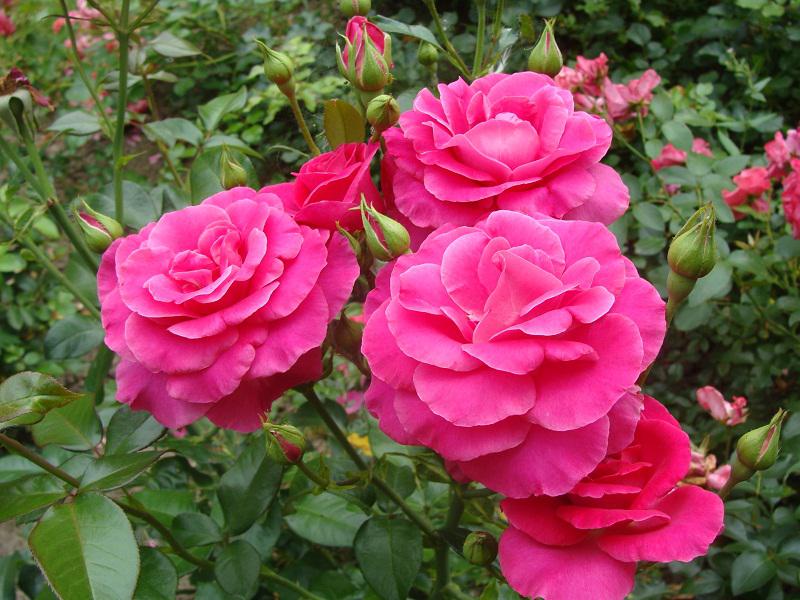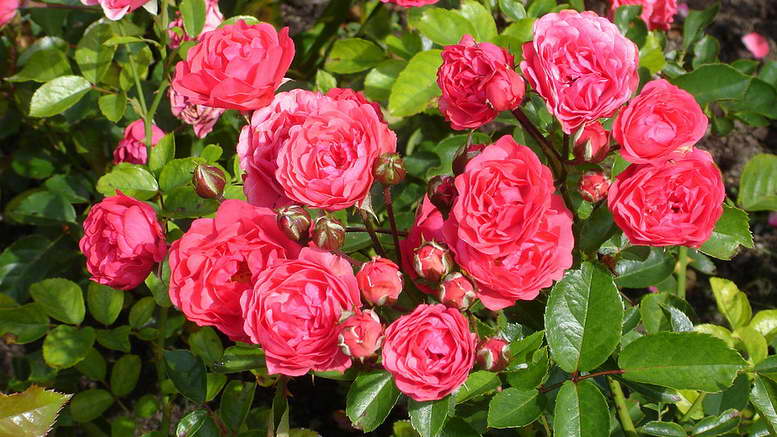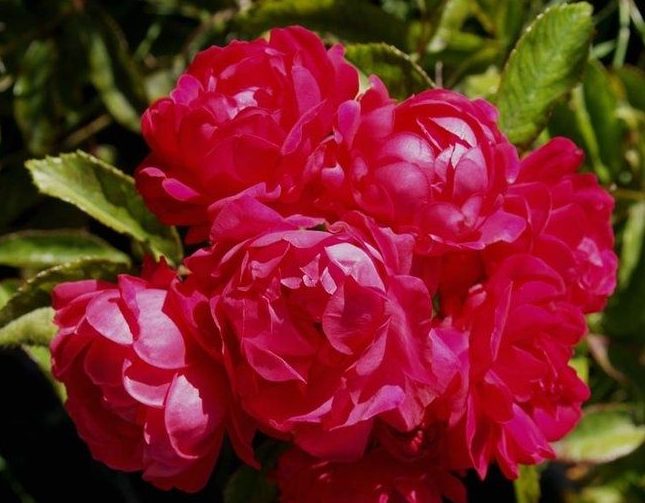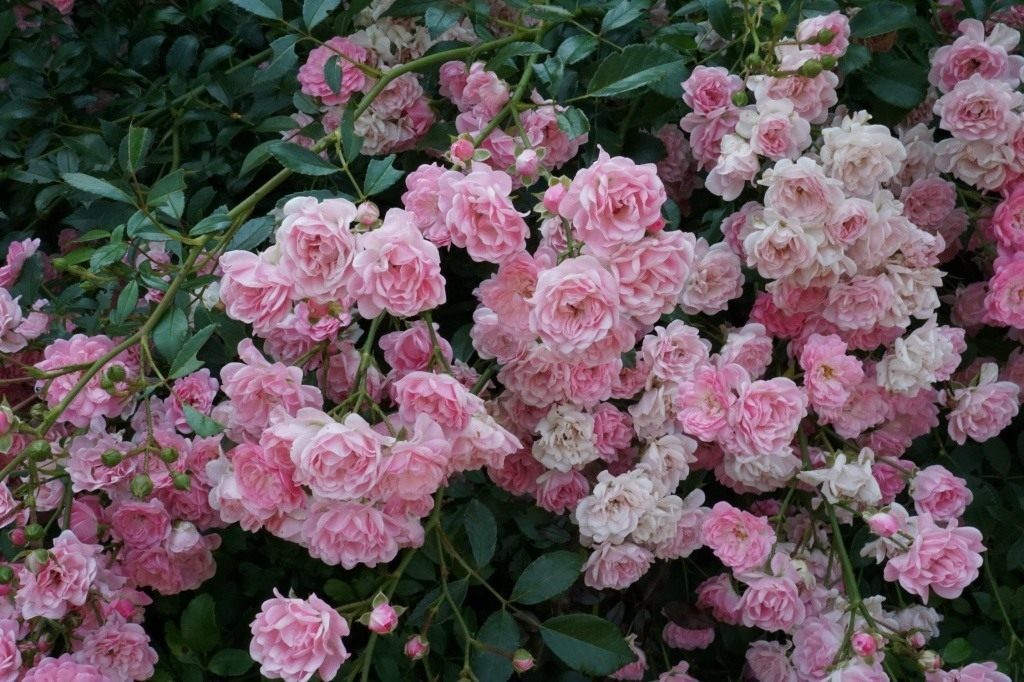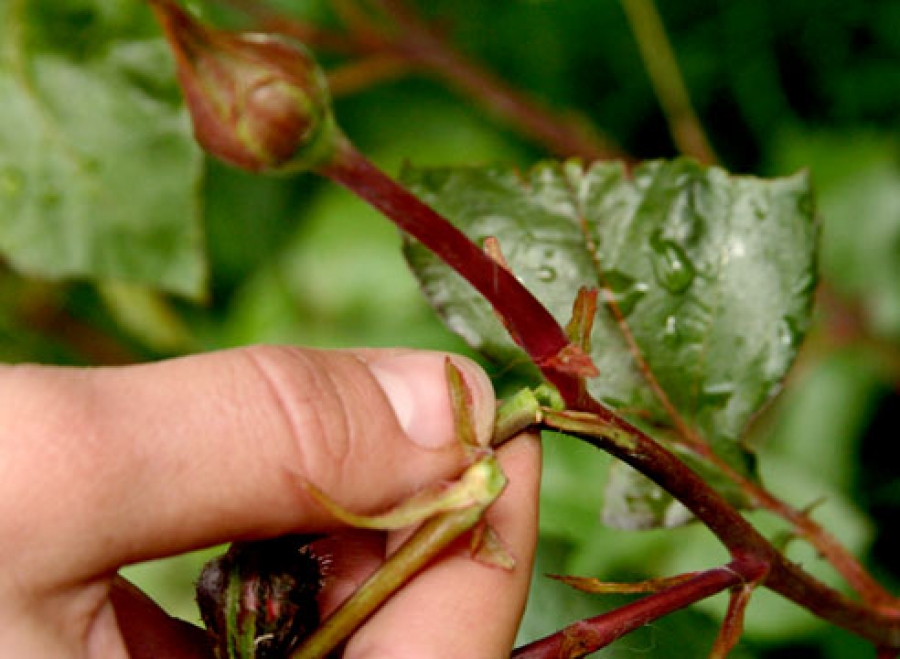Content:
Polyanthus rose is a hybrid variety of multi-flowered roses, which is currently a fairly distinct group of varieties. So what is it - polyanthus roses and how is this variety different from others?
They can be distinguished from other plants by their characteristic features: a bush of small height, foliage is thick and dense, flowers are small and bright, collected in inflorescences. Polyanthus roses can bloom until mid-autumn and the onset of frost.
Polyanthus roses: meaning, origin, application
The word “polyanthus” is derived from the Latin “poly”, which means “many”, and “ant”, which means “flower”. This word can be translated literally as "multi-flowered". The name clearly expresses the main distinguishing feature of this variety of roses.
For the first time, the Polyantha-Rose variety was obtained in 1873 in France by the originator Jean Baptiste. At the moment, two versions of the origin are assumed:
- crossing Rosa chinensis and dwarf Rosa multiflora;
- crossing of multi-flowered roses and re-flowering Hybrid Tea.
The first crosses were Paguerette and Magnonette. In 1884, Quarry merged the hybrids into a separate group of polyanthus roses. After that, the development of the group was taken up by the descendants of Jean Baptiste Guillot.
Polyanthus roses are used for different purposes. They can be planted separately or in groups, and depending on the conditions and design situations, low-growing or tall varieties are chosen.
Roses can blend in with a wide variety of atmospheres. With their help, a wide variety of compositions in landscape design are created. Roses are used for landscaping the area next to buildings, they decorate lawns and sidewalks. They are planted along curbs, roads, sidewalks. Some varieties can be used for standard decoration and in rocky gardens. Stunted can even decorate a room and courtyard. And the rose Gloria Mundi, for example, is suitable for making bouquets.
Plant characteristic
At the moment, there are more than a dozen varieties of polyanthus roses, so it is difficult to give an accurate description. However, all varieties have basic similar characteristics, which allow them to be combined into one group.
The height of the shrub can range from 30 to 70 cm, depending on whether the variety is undersized or tall. The bush itself is branchy and lush.
The foliage is small, but very dense, the color of the leaves is rich green. Shield-shaped inflorescences consist of flowers up to 6 cm in diameter, the number of flowers in one inflorescence can sometimes reach 40-50. The varieties do not differ in color variety, usually they are flowers of red and pink shades. Sometimes there are varieties with white or orange flowers. But at the same time, the color is bright and saturated, so the scarcity of shades is compensated for. The most common shape of the bud is cupped.Small size red or orange polyanthus rose fruits with seeds inside.
Pollination occurs with the help of insects and wind. Polyanthus roses bloom in mid-June and ends in October. The variety is resistant to temperature changes and frost, if the plant is provided with a shelter. Frozen bushes recover quickly after frost and sprout new branches from the root.
Characteristics of species and varieties of crops
Polyanthus rose varieties are a large group that has many characteristics that differ from each other, but at the same time have the same origin and common features.
- The Fairyland polyanthus rose was obtained by Harkness in 1977 in the UK and registered in 1980. The height of the bush reaches 75 cm, and the width is slightly more than 1 m. A distinctive feature of the variety is the rosette-shaped flowers of pale pink color. The aroma emanating from the flowers is light and delicate.
You can find this variety under the names Harlayalong, ground cover rose, and spray rose.
- The Lady Reading variety was bred by Van Cleef in 1921. The height of the bush is slightly more than 1 m, the width also reaches 1 m. The double flowers have a rich red color.
- The rose bush of the Marjorie Fair variety reaches 1.3 m in height and width. The flowers are bright crimson with a white center.
It is sometimes sold under the name Red Ballerina as well as Red Yesterday.
- The old polyanthus rose variety Mevrouw Nathalie Nypels was obtained in 1919 in the Netherlands by an unknown breeder. The name, presumably, is a dedication to an unknown lady named Natalie.
The height of the bush is no more than 75 cm, and the width reaches 60 cm. The flowers are semi-double, pink. The aroma is sweet.
Some catalogs assign the variety to another group of Rosaceae - Floribunda.
- Orange Triumpf is a variety bred in Germany in 1937 by Wilhelm Cordes II of the famous "pink" dynasty of Cordes.
Rose Orange Triumph can reach a height of 1 m, and a width of 70-75 cm. Double flowers have a rich red color. There is no particular aroma.
- Rose The Fairy was obtained in 1932 in the UK by Ann Benthol. On the basis of this unique variety, several more varieties were bred.
The rose differs from other varieties by its unpretentiousness and the absence of periods of rest between flowering. For this reason, the bushes are often used as a ground cover plant. The variety is especially suitable for beginner gardeners.
The height of the bush and its width range from 60 to 90 cm. The flowers of the rose are rosette-shaped, the color is pink. The variety has a light pleasant aroma.
- Kubinochka is a variety obtained by Vera Nikolaevna Klimenko in the Crimea in 1959. The flowers are bright pink, the center is yellow. The rose has a classic scent of polyanthus rose.
Features of planting and caring for the crop in the open field and at home
There are two ways to plant a polyanthus rose. The first is to grow from seeds. The seeds must be soaked in water and kept at room temperature. After 2 weeks, they can be sown in a previously prepared and moistened substrate for better plant development. You need to plant to a depth of half a centimeter.
The most suitable time for planting seeds is December, then before planting in open ground, the seeds will have time to rise and grow stronger. Seed containers should be covered with glass or foil. Keep them in a cool place, from time to time open for fresh air and humidify.
After a month, shoots usually sprout, after which they can be placed in a sunny, cool place so that direct sunlight does not fall on the bush.
Bushes can be planted from April. It is necessary to dig a hole 20-30 centimeters deep. It needs to be filled with a drainage mixture of coarse sand, ash and compost. The bush settles to a depth of 5 to 10 cm.
The second method of planting is by cuttings. It is most common among gardeners when growing roses. Its advantages are simplicity and effectiveness. Rooting can be done at any time of the year.
Caring for a polyanthus rose involves pruning. It is advisable to spend it in the spring. First, dried and damaged branches are removed from the bush. Then the whole and healthy branches are shortened by a third, but so that each shoot has from 3 to 5 buds. During the entire flowering period, you need to update the bush, remove dried branches and flowers. This stimulates the appearance of new shoots and buds.
You need to water the bushes once a week, provided that there was no rainfall during this time. To stimulate flowering, it is recommended to feed the plant. Polyanthus roses love mineral fertilizers, and in addition, you can prepare a special solution from chicken manure.
After August, it is strongly discouraged to water and prune the bushes so that the bush has time to prepare for the coming cold weather. When the first frosts come, you need to huddle the bushes by 10 cm and close them with spruce branches or a cloth.
Major diseases and pests of crops and measures to control them
One of the advantages of the polyanthus rose is its resistance to fungi and humid climates. But she cannot resist some diseases and insect pests, which is worth remembering when caring for a rose.
The most common types of insects attacking polyanthus roses are:
- Aphid. It is necessary to remove the parts of the plant affected by insects, and then spray the bush with a solution of wormwood or chemical agents intended for pest control. To prepare a solution of wormwood, pour 35 g of wormwood with 10 liters of warm water, let it brew. Before spraying, the required amount of tincture is diluted with water in a ratio of 1 to 3.
- Rose leafhoppers. A sign of infection is white spots on the leaves. A solution of ordinary laundry soap will help get rid of the pest.
- Spider mite. The symptom is yellow and gray spots on the leaves. The first step is to remove the affected leaves. After that, you need to spray the plant with a decoction of horsetail or tincture of garlic.
- Rose leaf roll. The insect causes great harm to the plant, so if the leaves of the rose begin to curl, you need to immediately remove them and treat the bush with insecticides.
- Rosy rotten. This type of insect lays eggs directly in the stems of a rosebush. You can find out about the presence of a pest by looking at the holes in the plant stems and in the leaves. First, you need to cut off the damaged areas of the bush and treat it with wormwood tincture.
The most common diseases of polyanthus roses:
- Powdery mildew. A symptom that speaks of a defeat is a white bloom on the leaves. It must be removed by spraying with a solution of Bordeaux liquid or a special agent - Topsin-M. Rosa Royal Minueto is especially susceptible to this disease, therefore special attention is required to this variety.
- Rust. Sign - the formation of yellowish brown spots. They are removed by spraying the shrub with a solution of Bordeaux liquid. It is necessary to treat the plant in this way 2 times a day for 3 days.
- Black spot. A typical symptom is dark spots on the outside of the leaf. Spraying with a decoction of horsetail, nettle or Hom helps to resist the disease. The Kubinochka variety is susceptible to this disease.
Polyanthus rose is a variety that is easy to care for. It is suitable for both novice gardeners and professional breeders. At the same time, the use of the variety is very diverse: flowers can be used in landscape design or simply to decorate your garden or room. This gives a lot of scope to the imagination of those interested in growing a polyanthus rose.
